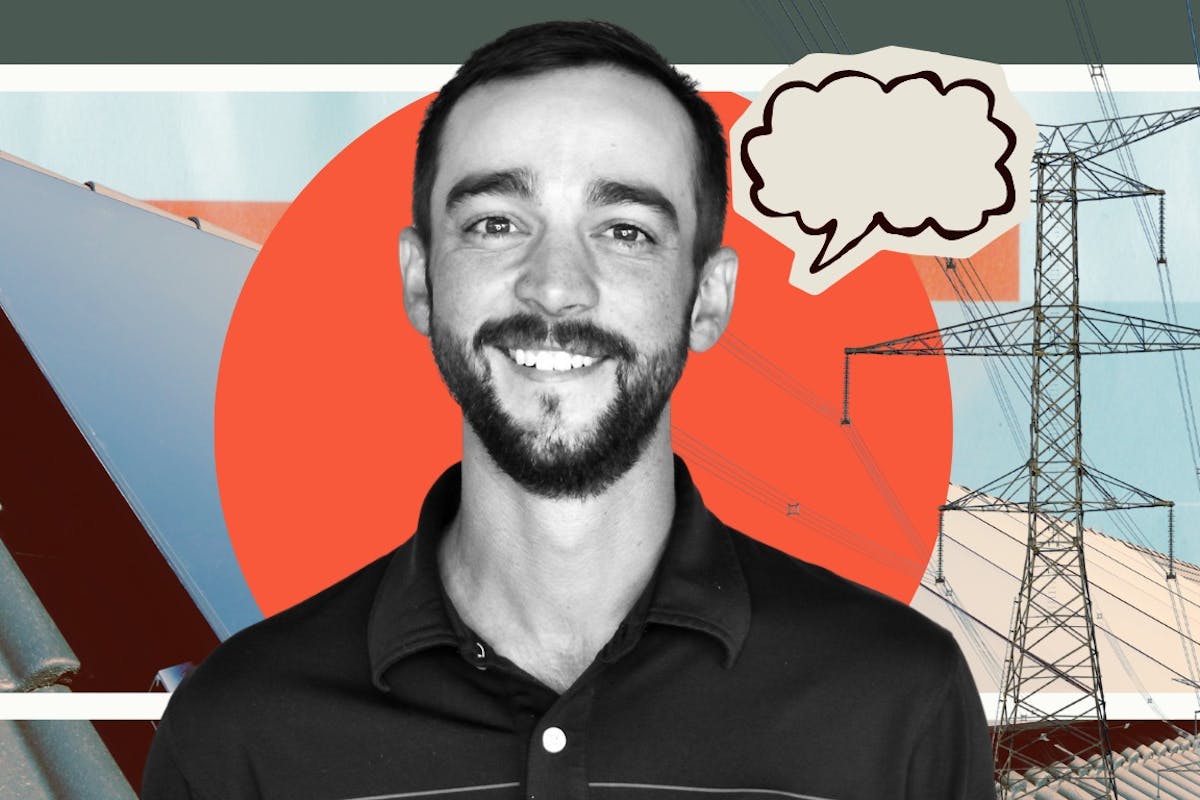What Is Climate Change? Causes, Effects, and Solutions
Last edited

Author
Andrew Blok
Electrification and Solar Writer and Editor

Editor
Ryan Barnett
SVP, Policy & New Market Development

Hotter temperatures, stronger storms, and changing weather patterns. That's what climate change can do.
As scientists plot temperatures and carbon in the atmosphere grow together, it's clear that too many greenhouse gases in the atmosphere is the root cause of climate change.
We know the causes of climate change, but we also know the solutions. Electrification with clean energy (along with other changes) will go a long way to addressing the root cause. Here's what you should know about climate change, its causes, effects, and solutions.
See how much you can save with home energy changes
Climate Change Definition: How Does It Work?
Climate change is the long-term increase in the Earth's average surface temperature and the large-scale changes in global, regional, and local weather patterns that result from that increase, caused by a significant increase in the greenhouse gases produced by the use of fossil fuels.
The specific way climate change works has been known for a long time. Eunice Foote, who ran experiments back in the 1800s, showed that glass tubes filled with carbon dioxide warmed up more than those filled with air when placed in the sun. She concluded that "an atmosphere of that gas [carbon dioxide] would give to our earth a high temperature.”
Since the 1960s, the levels of carbon dioxide in the atmosphere have risen from less than 320 parts per million to more than 420 parts per million. While that may seem like a small shift, it’s enough to make a huge difference.
Carbon dioxide works a bit like the glass of a greenhouse (hence the name “greenhouse gas”). Greenhouses (or your car’s interior) let light pass through them, but trap some of the heat. That’s why it can get even hotter inside your car than it is outside. Carbon dioxide and other greenhouse gases trap some of the sun’s heat on earth. That’s obviously good to a certain extent. We couldn’t live on a planet that didn’t trap any heat. But trapping too much can be a problem.
There are natural sources of carbon dioxide — people breathing, plants and animals decomposing, and even some geological events — but only the last few hundred years of burning fossil fuels, like oil, coal, and natural gas, account for the present rise in carbon dioxide. Other greenhouse gases, like methane, nitrous oxide, hydrofluorocarbons (also known as HFCs), also trap heat.
As the planet warms, temperatures rise, which has a ton of secondary effects. Precipitation patterns change. Long-frozen ice at the poles and on mountains melt. Plants and animals are forced to adapt to new climates. Sea levels rise.

Credit: NOAA
Here are some key climate change statistics from NASA.
- Over the last two centuries, the global average temperature of the earth’s surface has risen by 2.12 degrees Fahrenheit (1.18 degrees Celsius).
- Between 1993 and 2019, there was an annual loss of 279 billion tons of ice in Greenland and 148 billion tons of ice in Antarctica, as ice sheets break off and eventually melt.
- There has been a 0.6 degree Fahrenheit (0.33 degree Celsius) rise in the temperature of the top 100 meters of the ocean since 1969.
As climate change science gets more precise, it's revealing how a warmer planet is making storms, droughts, floods, and other extreme weather worse.
Climate Change Causes
Earth’s climate has changed over its history, but the rate and scale of change occurring now can only be explained by the rise of greenhouse gases in the atmosphere. Still, natural causes can have a demonstrable effect, like when Mount Pinatubo’s eruption reduced global temperatures by 0.5 degrees Celsius in the following year. Changes in the sun’s 11-year cycle of brightness also have a small effect.
Unfortunately, those natural causes can’t explain the sustained level of warming that Earth is experiencing. That can only be explained by human activity.
Burning fossil fuels is the main cause of climate change. However, there are different ways they’re used and non-fossil fuel factors play a role, too.
- Fossil fuels: When fossil fuels are burned, whether to fuel a vehicle, generate electricity, or manufacture goods, they release carbon dioxide and other greenhouse gases into the atmosphere. Extracting fossil fuels from the ground and transporting them can also contribute in the form of methane leaks.
- Manufacturing: Making things takes energy, which often comes from fossil fuels. Sometimes the process of making the product (like cement) releases greenhouse gases.
- Transportation: Most vehicles used to move people and goods run on fossil fuels. The cement used to build transportation infrastructure is also a significant source of greenhouse gases.
- Deforestation: Plants breathe in and store carbon dioxide, which makes them an essential part of life on this planet. When trees are cut down without planting new ones, that carbon dioxide goes back to the atmosphere.
- Agribusiness: Everyone needs to eat, but some foods have a larger impact on the climate. Diets rich in plants and low in meat produce fewer carbon emissions.
To find out how you can reduce your climate impact at home, download the Palmetto app. You'll get insight into how you can save energy (and money!), all while earning discounts on energy saving devices.
See how much you can save with home energy changes
What Are Greenhouse Gases?
Greenhouse gases are the gases that contribute directly to the greenhouse effect by trapping heat in the atmosphere.
- Carbon dioxide traps heat in the atmosphere, resulting in global warming. While there are natural sources of carbon dioxide (like your breath), the amounts causing global warming can only come from burning fossil fuels. It can stay in the atmosphere for 300 to 1,000 years, according to NASA.
- Methane is a more potent greenhouse gas than carbon dioxide, though it lasts a shorter time in the atmosphere.
- Nitrous oxide can remain in the atmosphere for 150 years, and is about 300 times more potent than carbon dioxide.
- Chlorofluorocarbons are used as refrigerants and aerosols. When they leak into the atmosphere, they contribute to the greenhouse effect.
- Hydrofluorocarbons were primarily used in refrigeration. They have been replaced by chlorofluorocarbons, but they still contribute to global warming.

Source: NOAA
Again, the greenhouse effect (and greenhouse gases) aren’t always a bad thing. Earth is habitable thanks to our atmosphere and its greenhouse effect. But too strong of a greenhouse effect can be bad, and throw off the balance that’s been around the entire time humans have been on Earth.
Climate Change Effects
Climate change impacts our world in a wide variety of ways.
- Weather: Unpredictable weather patterns can make food production difficult. Extreme weather will get worse thanks to climate change and be more costly, damaging, and dangerous. Heat waves, hurricanes, and more are likely to become more frequent and severe.
- Sea level rise: As polar ice caps melt and oceans warm, sea levels begin to rise. This could displace millions of people worldwide as well as destroy coastal ecosystems.
- Ocean acidification: As the oceans absorb carbon dioxide from the atmosphere, they become increasingly acidic, which can be dangerous to coral and marine life.
- Plant and animal life: Plants and animals will need to adapt to changes in long established seasonal and weather patterns. Many plants and animals face extinction from climate change.
What Is the Difference Between Weather and Climate?
Climate and weather are different things. It's why one cold snap in winter isn't proof climate change isn't happening.
For the record, here’s the difference.
- Weather: The local meteorological conditions experienced over short periods of time, including temperature, precipitation, wind speed, humidity, and visibility.
- Climate: The long-term average of patterns and trends in weather over longer time periods.
What Is the Difference Between Global Warming and Climate Change?
The two most popular terms used to describe the earth's increasing temperatures are global warming and climate change. These relate to both short-term and long-term trends for both weather and climate. While they're often used interchangeably, there's a slight difference between them.
- Global warming: The rising average temperature of the earth's lower layers, including the ocean and atmosphere due to heat being trapped in the earth's atmosphere due to greenhouse gases.
- Climate change: The entire group of changes due to greenhouse gas accumulation, including warming, but also changes in precipitation patterns, melting ice, rising seas, and more.
Climate change is often the preferred term because of its broader application.
How Is Climate Change Measured?
Given that climate change occurs over a long period of time, measuring it can be challenging. Scientists track it in a few different ways.
- Surface temperature: This is the temperature of the air, land, and water on the surface level. It is a direct measure of global warming. The global annual average temperature has risen more than 1° Celsius from the average at the start of the Industrial Revolution.
- Sea level rise: While this is a slower process, melted ice and warmer oceans causes sea levels to rise. Since 1880, sea levels have risen about 8-9 inches, though not evenly around the world.
- Parts per million of greenhouse gases: This is the measurement of greenhouse gases in the atmosphere. Carbon dioxide has risen from below 320 ppm to more than 420 ppm since 1960.
Can We Slow Down Climate Change?
While people have a role in causing climate change, they can also play a role in fixing it. It's why Palmetto believes in creating a clean energy future. Addressing climate change will take people acting at the individual level and as companies, governments, and international organizations.

Credit: IPCC
On the individual level, improvements like solar panels and heat pumps, can reduce your home's contribution to climate change. Pairing home electrification with solar can have a significant impact.
To learn more about generating clean energy at home from solar panels, get a free solar savings estimate today. And download the Palmetto App today for fun and easy tips on how to reduce your energy use at home and to earn real discounts on energy saving devices.
See what home electrification can do for you:
Frequently Asked Questions
What are the main causes of climate change?
Burning fossil fuels for energy, manufacturing, and transportation is the leading source of greenhouse gases, which trap heat in the atmosphere. Deforestation, food production, and overconsumption are other factors.
What is the simple definition of climate change?
Human-caused climate change encompasses the changes occurring on Earth thanks to a warming planet caused mainly by the burning of fossil fuels.
Why is climate change a problem?
The effects of climate change can be harmful to human, animal, and plant life. Rising sea levels from melting ice can threaten coastal communities. Extreme heat is on the rise and will be more common on a warmer planet. Extreme weather, like hurricanes and flooding, are also expected to be more frequent, thanks to climate change.


